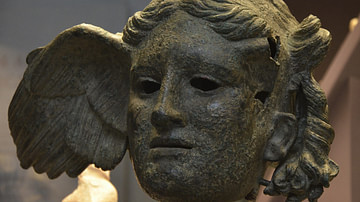
The term "Slavs" designates an ethnic group of people who share a long-term cultural continuity and who speak a set of related languages known as the Slavic languages (all of which belong to the Indo-European language family). Little is known about the Slavs before they are mentioned in Byzantine records of the 6th century CE, and most of what we know about them prior to this time is mainly derived from archaeological and linguistic studies. The Byzantine authors refer to the Slavs as "Sclaveni".
THE ORIGIN OF THE SLAVS
The Slavs are the least documented group among the so called "barbarian" enemies of Rome during late antiquity, so there is no scholarly consensus regarding their origin. Authors who wrote about the Slavs do not agree: some say the Slavs were nomads, and others claim they lived in permanent settlements located in forests and swamps; some accounts say they lived under the rule of a king, while others that they embraced a form of democracy. In addition to these discrepancies, we must bear in mind that most of these accounts are filled with the bias of the Romans, who saw all barbarian peoples as primitive, uncivilized, and violent.
Some authors have traced the origin of the Slavs back to indigenous Iron Age tribes living in the valleys of the Oder and Vistula rivers (in present-day Poland and the Czech Republic) around the 1st century CE. This is, however, still a matter of debate. Based on archaeological evidence, we know that Proto-Slavic people were already active by 1,500 BCE within an area that stretched roughly from western Poland to the Dnieper River in Belarus. Rather than having a centre of origin of the Slavic culture, it seems more reasonable to consider a wide territory in which a common cultural trait was shared by its inhabitants.
Linguistic evidence suggests that at some stage during their early times, the territory of the Slavs reached into the western region of Russia and the southern Russian steppes, where they came in contact with Iranian speaking groups. This is based on Slavic languages sharing a striking number of words with the Iranian languages, which can only be explained through diffusion from Iranian into Slavic. Later on, as they moved westward, they came into contact with German tribes and again borrowed several additional terms from Germanic languages. Interestingly, a Polish thinker named Józef Rostafiński had noticed that in all Slavic languages the words for beech, larch, and yew are borrowed from foreign languages, which implies that during early times these type of trees were unknown to the Slavs, a suggestion that could be used as a clue to determine where the Slavic culture originated.
SLAVIC MYTHOLOGY
We have very little Slavic mythological material; writing wasn't introduced into Slavic culture until the 9th and 10th centuries CE, during the process of Christianisation.
One important god of the Slavs was Perun, who was related to the Baltic god Perkuno. Like the Norse god Thor, Perun was a thunder god, considered a supreme god by some Slavs, just like Thor was considered the most important god by some Germanic peoples. The male god of youth and spring, named Jarilo (or Iarilo), and his female counterpart, Lada, the goddess of love, were also ranked highly in the Slavic pantheon. Both Jarilo and Lada were gods who died and were resurrected each year, and Jarilo in particular might have had a connection with fertility motifs. During the rise of Christianity, Jarilo played an important role, as he had some attributes in common with Jesus Christ.
Several multiple-headed gods were also included in Slavic mythology, such as Svantovit (or Svantevit), the god of war, who had four heads, two of them males and the other two females; Porevit, with five heads, representing the summer; Rujevit, with seven faces, the incarnation of autumn; and Triglav, who displayed three heads and was simultaneously looking into the sky, the earth, and the underworld.
THE SLAVS DURING the LATER ROMAN EMPIRE
In the middle of the 5th century CE, a political vacuum affected the entire region of the Balkans as a result of the fall of the Hunnic Empire. Attila's campaigns left large areas south of the Danube unsuitable for living and therefore empty. The borders of the Roman Empire bordering the Balkans were kept with difficulty, as new groups were moving within the devastated region. Among these new groups were the Slavs.
Between 531 and 534 CE Roman forces engaged in a series of military campaigns against the Slavs and other groups. During the 550s CE the Slavs advanced towards Thessalonica, entering the region of the Hebrus River and the Thracian coast, destroying several fortified settlements and (according to Roman sources) turning women and children into slaves and killing the adult males. However, they could not reach their target: Thessalonica was saved from disaster due to the presence of a Roman army under the command of Germanus. Later during the early 580s CE, the Slavs combined with the Avars to overwhelm Greece, Thrace, and Thessaly.
The Romans made a pact with the Avars, who received an annual payment of 100,000 gold solidi in return for leaving the Roman borders untouched. The Slavs, on the other hand, did not take part in the agreement, and they marched on to Constantinople in 585 CE but were driven off by the Roman defence. The Slavs continued attacking other settlements, and they finally established the first Slavic permanent settlements in Greece.
Early in the 600s CE, Rome organized a campaign against the Slavs with no positive results. The Slavs and the Avars joined together once again, forming a massive force in 626 CE and, aided by the Bulgars, laid siege to Constantinople. The barbarian coalition almost accomplished its goal, but the Romans managed to repel the attack. After this event, the Avar-Slav alliance came to an end. The Slav occupation of Greece lasted until the 9th century CE, when the Byzantines finally expelled them. By that time, the Slavs had a solid presence in the Balkans and other regions in central and eastern Europe.
CULTURAL DIVERGENCE OF THE SLAVS
Early in the Middle Age, the Slavs occupied a large region, which encouraged the emergence of several independent Slav states. From the 10th century CE onwards, the Slavs underwent a process of gradual cultural divergence that produced a set of closely related but mutually unintelligible languages classified as part of the Slavic branch of the Indo-European language family.
Today, a large number of Slavic languages are still spoken including Bulgarian, Czech, Croatian, Polish, Serbian, Slovak, Russian, and many others, stretching from central and eastern Europe down into Russia.







